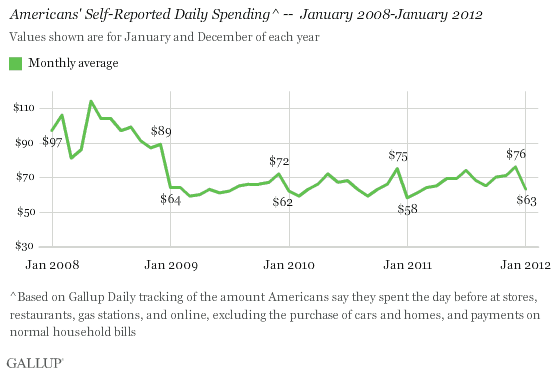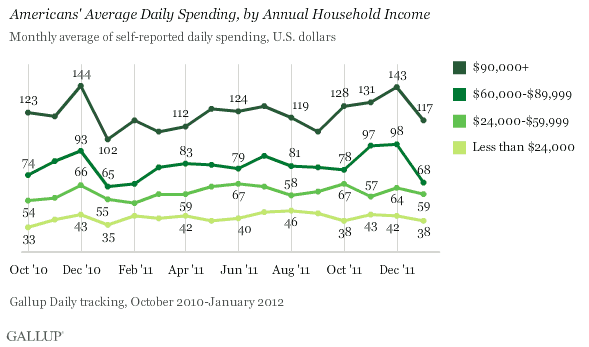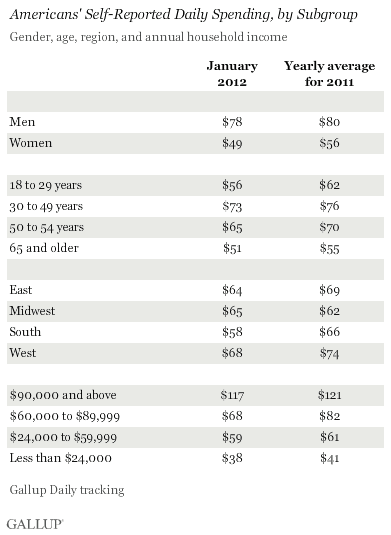PRINCETON, NJ -- Americans' self-reported daily spending averaged $63 in January, down from $76 in December but similar to the January spending levels in each of the last three years. Further, the $13 decline in average daily spending between December 2011 and January 2012 is typical of the post-holiday shopping season decline that Gallup has seen since 2010.

January spending in 2009 dropped by $25 -- more than Gallup has typically seen in four years of tracking this metric daily. This echoed the decline in Americans' confidence in the economy around the same time as problems in the labor, housing, and stock markets ensuing from the global financial crisis dominated economic news. Spending has largely been subdued ever since, and the spikes in self-reported spending seen each December have quickly ended each January.
Higher-Income Americans Pulled Back the Most
Most of the decline in overall consumer spending last month was the result of sharp cutbacks among affluent and upper-middle-income Americans -- those in households earning at least $90,000 a year and between $60,000 and $89,999 per year, respectively. Spending among both groups rose especially sharply over the holiday period -- between October and December -- and subsequently declined the most in January. By contrast, middle- and lower-income Americans' spending had been fairly flat across this entire four-month period.
A similar pattern was seen spanning the October to January period in 2010-2011, although spending was not quite as flat as in this cycle among the two lower-income groups.

Apart from high-income Americans, the biggest spenders in January were men, adults aged 30 to 49, and residents of the West. These findings are consistent with the broader patterns seen in Gallup Daily tracking of consumers' self-reported spending throughout 2011.

Bottom Line
January typically brings an abrupt end to the spending spree Americans go on each holiday season, and this January was no exception. Retailers certainly expect this and plan for it. Perhaps the good news in this year's figures is that spending declined by no more than the normal amount seen in each of the prior two years, and that decline was not nearly as extreme as the one in 2009.
Gallup's monthly averages since January 2009 suggest spending will continue to be subdued through March, but should start to pick up again in April, and further still in May.
Gallup.com reports results from these indexes in daily, weekly, and monthly averages and in Gallup.com stories. Complete trend data are always available to view and export in the following charts:
Daily: Employment, Economic Confidence and Job Creation, Consumer Spending
Weekly: Employment, Economic Confidence, Job Creation, Consumer Spending
Read more about Gallup's economic measures.
View our economic release schedule.
Survey Methods
Results are based on telephone interviews conducted as part of Gallup Daily tracking Jan. 2-31, 2012, with a random sample of 15,013 adults, aged 18 and older, living in all 50 U.S. states and the District of Columbia.
For results based on the total sample of national adults, one can say with 95% confidence that the maximum margin of sampling error is ±1 percentage point.
Interviews are conducted with respondents on landline telephones and cellular phones, with interviews conducted in Spanish for respondents who are primarily Spanish-speaking. Each sample includes a minimum quota of 400 cell phone respondents and 600 landline respondents per 1,000 national adults, with additional minimum quotas among landline respondents by region. Landline telephone numbers are chosen at random among listed telephone numbers. Cell phone numbers are selected using random-digit-dial methods. Landline respondents are chosen at random within each household on the basis of which member had the most recent birthday.
Samples are weighted by gender, age, race, Hispanic ethnicity, education, region, adults in the household, and phone status (cell phone only/landline only/both, cell phone mostly, and having an unlisted landline number). Demographic weighting targets are based on the March 2011 Current Population Survey figures for the aged 18 and older non-institutionalized population living in U.S. telephone households. All reported margins of sampling error include the computed design effects for weighting and sample design.
The questions reported here were asked of a random half-sample of respondents for 30 nights on the Gallup Daily tracking survey.
In addition to sampling error, question wording and practical difficulties in conducting surveys can introduce error or bias into the findings of public opinion polls.
For more details on Gallup's polling methodology, visit www.gallup.com.
